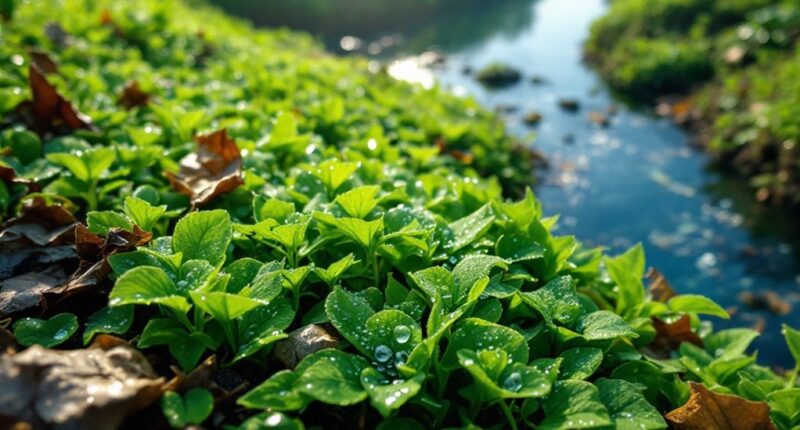Water footprint assessment is like taking a water-use selfie, showing how much freshwater goes into producing goods and services. It breaks down usage into three types: green (rainwater), blue (surface and groundwater), and grey (water for pollution dilution). This snapshot helps identify water-guzzling processes, guiding strategies for conservation. Picture it as a treasure map for sustainable practices! Curious about how these insights can transform your favorite products? There’s more to uncover in this exciting water dialogue!

Water is the lifeblood of our planet, and understanding how we use it is more essential than ever. Enter the concept of water footprint assessment, a clever way to quantify the volume of freshwater consumed in the production of goods and services. Think of it as a backstage pass to the water consumption show, highlighting both direct and indirect usage. Through this assessment, we can understand not just how much water we’re guzzling but also the sustainability and efficiency of our usage.
The water footprint breaks down into three main types: green, blue, and grey. Green is the rainwater that plants drink; blue is what we pull from rivers and aquifers, and grey is the amount required to dilute pollutants—like the unsung hero of water conservation. This multi-faceted approach examines everything from the water used in agriculture to the hidden water in the goods we consume, giving a detailed picture of our water habits.
Understanding the three types of water footprint—green, blue, and grey—illuminates our water consumption habits and conservation efforts.
To get to the nitty-gritty, the assessment follows a four-phase process that includes setting goals, accounting for water use, evaluating sustainability, and formulating responses. It’s a bit like trying to figure out how much pizza you can eat without regretting it later—tracking every slice and crumb along the way. Utilizing global databases and local data helps guarantee that these calculations are as accurate as a high-tech pizza cutter. This assessment is versatile and can inform strategic actions and policies from environmental, social, and economic perspectives. Furthermore, it is important to note that water footprint assessments can be standalone evaluations or part of a larger life cycle assessment framework.
The benefits of water footprint assessments are substantial. They reveal water-hungry processes in supply chains and help develop strategies to mitigate excessive use. However, challenges persist, like the lack of consistent data or the complexity of indirect water use.
As we look to the future, refining methodologies and linking water footprint assessments with other environmental metrics will be important. Like a well-crafted recipe, the right blend of data and creativity can help us make smarter choices about one of our planet’s most precious resources.
Frequently Asked Questions
How Can I Calculate My Personal Water Footprint at Home?
To calculate a personal water footprint at home, individuals can utilize various online calculators designed for this purpose. These tools take into account factors like direct water use—think your daily showers—and indirect usage, which includes everything from your favorite avocado toast to energy consumption.
What Are the Main Components of a Water Footprint?
The water footprint comprises three main components: blue, green, and grey water.
Blue water is the tangible volume from surface and groundwater, like the water used for irrigation or industry—think of it as the “thirsty” water.
Green water refers to rainwater stored in soil, nourishing plants—nature’s free hydration.
Finally, grey water measures the freshwater needed to clean up pollution—like the clean-up crew after a messy party. Together, they reveal our water usage story
How Does Climate Change Impact Water Availability?
Climate change is like a sneaky magician, altering water availability with a flick of its wand. Rising temperatures boost evaporation, leaving some regions drier than a desert. Intense rainfall might grace the lucky ones, but it’s often unpredictable, like a surprise pop quiz.
Meanwhile, melting glaciers, the earth’s icy savings account, threaten water supplies for millions. By 2050, water scarcity could become the new normal for billions, transforming hydration into a high-stakes game.
Are There Specific Apps for Tracking Water Usage?
In today’s tech-savvy world, tracking water usage has never been easier, thanks to a plethora of innovative apps.
Dropcountr provides real-time data from utilities, while EyeOnWater alerts users about leaks.
For a bit of fun, H2O Tracker turns conservation into a game.
Meanwhile, smart water meters like Bluebot watch over your water usage 24/7.
With these tools, staying mindful of water consumption is just a tap away—no superhero cape required!
How Can Businesses Reduce Their Water Footprint Effectively?
Businesses can effectively reduce their water footprint by conducting thorough audits to pinpoint high usage areas, much like detectives solving a case. Installing water-efficient technologies, such as low-flow fixtures, is akin to giving plumbing a much-needed makeover.
Training employees on conservation practices creates a culture of awareness, while engaging suppliers secures everyone’s alignment. Finally, monitoring progress keeps the conservation game strong, preventing any sneaky leaks from crashing the party.









